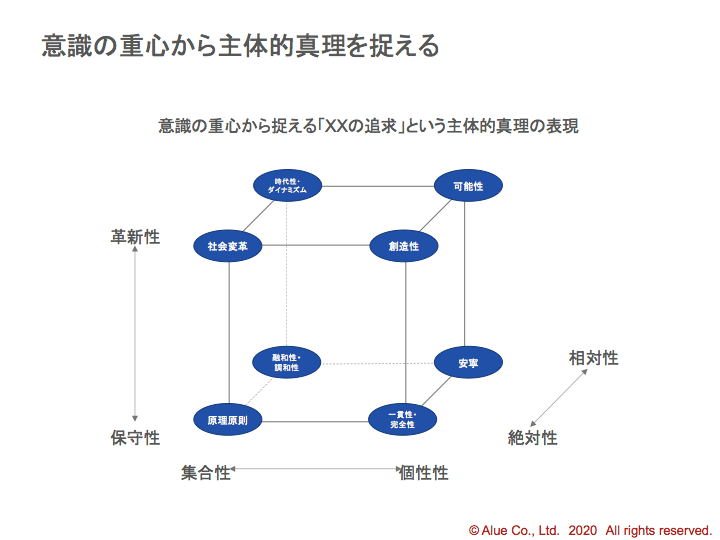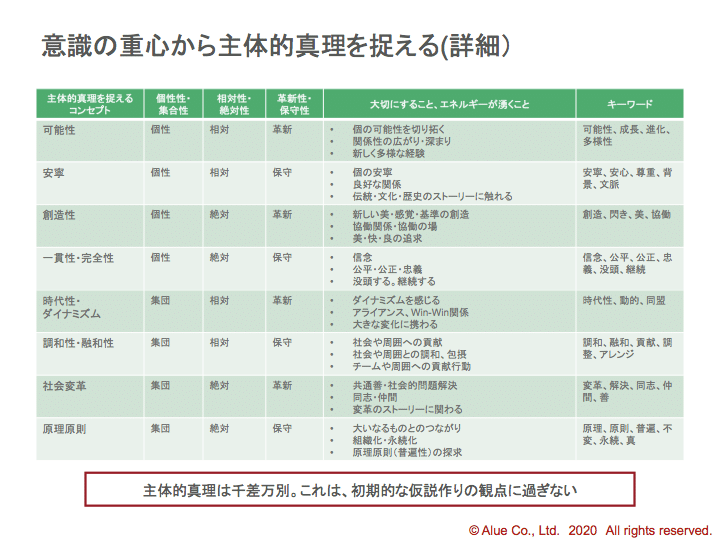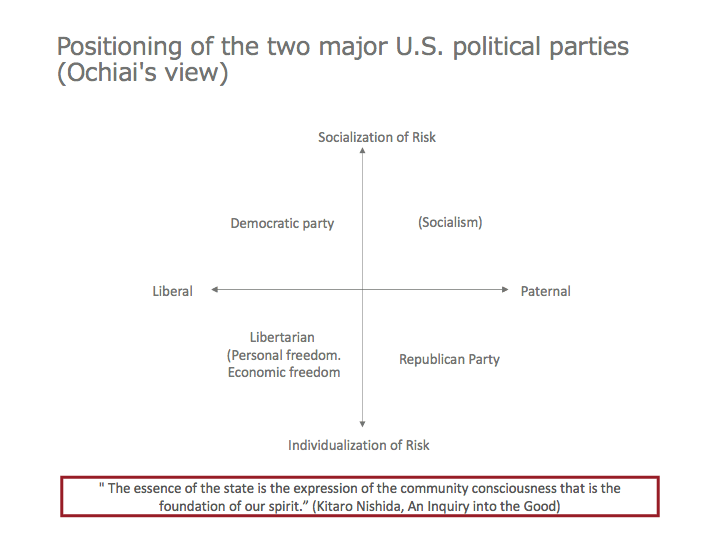
主体的真理を捉えるためには、どうしたらいいのか?②
前回の記事では、主体的真理を捉えるために、これまでの経験や現在の活動から、自分が変わらずに大切にしていることの源泉を辿っていく方法についてお話しました。今回の記事では、自分の意識の重心を直感的・抽象的に捉えて、その妥当性を検証する方法についてお話しします。
(前回の記事をまだ読んでいない方は、是非とも併せてお読みください)
この2つの方法は、どちらが良いという話ではなく、自分にとってピンとくる方法から始めれば良いと思いますし、可能であれば、両方のアプローチを試して見て主体的真理を多面的に捉えていくと良いと思います。
3つの軸で自分の意識の重心を捉える
結論から言えば、3つの軸から自分の意識の重心を捉えてみることをお勧めします。これは、何かの理論に基づくというよりも筆者による仮説というレベルであることを先にお伝えさせていただきます。あくまでも主体的真理を捉えることが目的ですので、そのための示唆を与えるアプローチの1つだと考えて頂ければと思います。

まず、このように3つの軸で構成される8つの領域(立方体のそれぞれの頂点)に分けることによって、何がいいのかという話をします。このようなアプローチの前提として、人にはそれぞれ意識の重心みたいなものがあると考えています。そしてその意識の重心に、主体的真理が表現されている可能性が高いという前提も持っています。
ですから、この3つの軸のそれぞれにおいて、自分の意識の重心がどちらになるかを捉えることによって、自分の主体的真理の居場所を大枠で捉えていこうというのがこのアプローチになります。
次にそれぞれの軸について説明をします。
集合性・・・メタ的・集合的・全体的なものを起点として捉える世界観
▼社会全体、人類全体、コミュニティ全体、生態系全体から捉える傾向
▼自分も全体の中の一部という捉え方
個性性・・・一人ひとりの自我や個性を起点として捉える世界観
▼一人ひとりの自我や個性から捉える傾向
▼自分を含めた一人ひとりが起点であり、全体という概念はあくまでも個性ある個が集まった結果であるという捉え方
相対性・・・価値観や基準は一人ひとりが決めるという世界観
▼何が良いかは一人ひとりで違うという考え方
▼価値観や基準を自分で決める自由が大切という捉え方
絶対性・・・価値観や基準を決める、普遍的なものがあるという世界観
▼何が良いかを決める、何らか普遍的な共通のものがあるという考え方
▼価値観や基準は、一定程度、普遍的・共通的なものに沿った方が良い(あるいは、沿うべき、沿わざるをえないという考え方)
革新性・・・これまでの慣習にとらわれず、いいものはどんどん変えていくべきという世界観
▼自分たちが考えだした新しいことは、これまでの人たちが考えていることよりも優れているという捉え方
▼新しいものに価値を見出す世界観
保守性・・・これまで培っていたことを大切にして、維持していくことが大切という世界観
▼自分たちが考え出すことは必ずしも優れているとは限らないから、これまでの先人たちが大切にしてきたことを大切にするのが良いという考え方
▼新しいものに価値を見出すのではなく、昔から一貫しているもの、あるいは将来に渡っても一貫するであろうことに価値を見出す世界観
さて、皆さんはそれぞれの軸において、どちらに意識の重心があるでしょうか?ここで、「重心」という表現をしているのには理由があります。上記のどの軸についても、場面によって違うなということを感じられた人も多いのではないでしょうか。これはその通りで、それぞれの軸について、片方の世界観しかもたないという話ではなく、状況によって使い分けているのが普通です。
ただし、どちらの方の世界観をより多く持っているか、より多く適用しているかについては個人差があり、それを「重心」と表現しています。
主体的真理によって、意識の重心の置きどころが変わる
3つの軸それぞれにおける意識の重心の置きどころの違いによって、主体的真理の質感がどのように変わるかをまとめたものが以下の図です。

3つの軸それぞれが当てはまるコンセプトと、大切にすること・エネルギーが湧くことを読んでいただいて、しっくりくるかどうかを確かめてみてください。あるいは、この表を見ながら、どれが一番自分にフィットするかを考えていただいても大丈夫です。
このときに、どれか1つに絞らなければいけないと考える必要はありません。この8つのうちの複数にまたがるような意識の重心がある場合もありますから、しっくりくる組み合わせを選んでいただいても大丈夫です。
ちなみに、私自身は、集合性・絶対性・保守性に意識の重心があります。そのコンセプトは、「原理原則」であり、「大いなるものとのつながり、組織化・永続化、原理原則(普遍性)の探求」を大切にしており、エネルギーが湧きます。
これは、私の主体的真理が「本質探求による大いなるものとの一致感」と表現していうことと合致します。
ここまで読まれた方の中で、「主体的真理は一人ひとり違って、千差万別なのだから、このようなカテゴリー分けは無意味なのではないか」と思った方もいらっしゃるかもしれません。それは、仰る通りで、主体的真理は一人ひとり違いますから、このような大雑把なカテゴリー分けですぐに見つかる類のものではありません。
それでも、一人ひとり違う主体的真理を何の手がかりもなく探していくよりも、大雑把な分類ではあるものの、最初の仮説作りとしてこのようなカテゴリ分けを用いることも有益ではないかと私が思っているのは、恐らく、私の意識の重心が相対性ー絶対性の軸において、絶対性にあるからなのでしょう。
相対性に意識の重心がある方にとっては、違和感があるアプローチかもしれませんので、その場合は、これまでの経験や現在の活動から、自分が変わらずに大切にしていることの源泉を辿っていく方法を試していただければと思います。
初期的な仮説から、自分の主体的真理を紡ぎ出す
先ほども述べたように、この8つのカテゴリー分けは、主体的真理をとらえていく初期的な仮説に過ぎません。自分がしっくりくる意識の重心が見つかったとしても、そこで満足せずに、それを初期仮説としてさらに自分の主体的真理をぴったり表現できるような言葉やイメージを探求していって頂きたいと思います。

どのように探求をすればいいのかについては、前回の記事でご紹介した、これまでの経験や現在の活動から、自分が変わらずに大切にしていることの源泉を辿っていく方法を併せて用いていただくことをお勧めします。
私の場合で言えば、これまでの経験や現在の活動から辿った自分の願いは以下のようなものでした。
▼テニス
・・・身体感覚を伴った没入感
▼物理・数学
・・・1つの法則で多くのものを説明できる美しさを見たい・感じたい
▼集団・チーム活動
・・・1人ではできない、集団やチームの力が発揮される瞬間を感じたい、見ていたい
▼教育ビジネスの起業
・・・本質を探求して、それが社会の基盤になる姿を実現したい、見てみたい
・・・1人ではできない、集団やチームの力が発揮される瞬間を感じたい
▼海外旅行・海外出張
・・・成長感を感じたい(ただし、これは条件付けの要素が多い)
・・・まだ見ぬ世界に触れてみたい、感じたい
▼学習
・・・成長感を感じたい(ただし、これは条件付けの要素が多い)
・・・新しい世界、新しい感覚に触れてみたい、感じたい
一方で、今回の記事にあるように、意識の重心から直感的・抽象的に捉えたコンセプトは、次のようなものでした。
コンセプト「原理原則」
大切にしていること・エネルギーが湧いてくること
▼大いなるものとのつながり
▼組織化・永続化
▼原理原則(普遍性)の探求
キーワード・・・原理、原則、普遍、不変、永続、真
この2つのアプローチを統合的に捉えていき、私自身の直感や感性にフィット感を問いながら言語化してみると次のようになります。
【私自身の主体的真理(を最大限純度高く表現したもの)】
本質追求による大いなるものとの一致感
【付随的な願い】
▼1人ではできない、集団やチームの力が発揮される瞬間を見たい
▼身体感覚・身体意識を中心としたフロー感覚を味わいたい
▼意識的に自由でありたい。新しい世界を見ることで、より広い意識空間の中で、意識の自由を感じていたい
なぜ、この3つの軸なのか?
ここまでの内容で、今回お話しすることのエッセンスは全てとなります。ここからの記事は、もう少し詳細に、この3つの軸で構造化される理由や背景はどのようなものかについてご関心のある方は、もう少々お付き合いいただければと思います。
この3つの軸によって、主体的真理につながる意識の重心の所在をカテゴリ化できるというのは、実証された理論ではなく、私の仮説になります。ただ、その仮説にたどり着いた経緯がありますので、それをご紹介させていただければと思います。
私がどのようにこの仮説に辿り着いたかと言えば、政治的立場をカテゴリわけするときの考え方をアナロジーとして用いています。米国で言えば、民主党と共和党という二大政党がありますが、その政治的立場は明確に異なります。その立場の違いを表す軸の取り方が3種類あります。
▼リスクの社会化・リスクの個人化
・・・生活をしていく上でのリスクを社会全体で受けるか、あるいは、個人が受けるか
▼リベラル(自由主義)・パターナル(権威主義)
・・・”いい”を決めるのは一人ひとりか、あるいは、”いい”は誰かが決めるのか
▼革新と保守
・・・(新しい)いいものはすぐにでも取り入れるべきか、あるいは、これまで大切にしてきたものを大切にして、拙速に取り入れるべきではないか
例えば、米国の二大政党は下記のように位置付けることができます。

民主党であればオバマ大統領、共和党であればブッシュ大統領やトランプ大統領を思い浮かべていただけると、上記の位置付けのイメージが腑に落ちやすいのではないでしょうか。
さて、これらは政治的立場の位置付けであって、主体的真理につながる意識の重心の話とは違うのではないかと思われた方もいるかもしれません。そもそも政治というのは何かと考えた時に、西田幾多郎の「善の研究」に載っている次の言葉を見て、ピンときたのです。
国家の本体は、我々の精神の根底である共同体意識の発現である
(西田幾多郎、善の研究)
西田幾多郎は、国家は集合意識が発現したものだと言っています。そうすると、政治的立場というのは、「政治政党がその立場をとっている」ということ以上に「そのような集合意識がある」ということ、さらにいえば、「その立場を大切にしている人が多くいる」ということになります。
我々の集合意識の発現である政治立場というものが、3つの軸によってカテゴリ化できるのであれば、我々個人の意識についても、本質的にはこの3つの軸によってカテゴリ化できるのではないと着想しました。
リスクの社会化とリスクの個人化という軸は、個人の文脈では何を意味しているかわかりませんので、抽象化すると集合性と個性性という軸と捉えることができるだろう。リベラル・パターナルという軸も、個人の文脈では意味がわかりにくいので、相対性と絶対性として捉えることができるだろうと考えたのです。
このような着想とアナロジーから、意識の重心を3つの軸でカテゴリ化できるのではないかと考えたわけですが、これが理論的に正しいと言えるのかどうかはわかりません。(関係のありそうな理論などありましたら、是非とも教えて頂ければ有難いです。)ただ、主体的真理を捉えていく上では、1つのアプローチにはなるだろうと思っています。
本日の問いとなります。(よろしければ、コメントにご意見ください)
・あなたの主体的真理につながる意識の重心を、3つの軸で捉えるならば、どこに位置付けられるでしょうか?
・上記の位置付けを初期仮説として、自分の主体的真理を(可能な範囲で無理なく)言語化するとすれば、どのような表現になるでしょうか?
What can we do to perceive the subjective truth? 2)
In my last article, I talked about how to trace the source of what we value unchangingly from our past experiences and current activities in order to perceive the subjective truth. In this article, I will talk about how to capture the tendency of our consciousness intuitively and abstractly, and test its validity.
I'm not talking about which of these two methods is better, but I think it's best to start with the method that feels right to us, and if possible, try out both approaches to get a multifaceted view of subjective truth.
Capture the tendency of one' s consciousness on three axes
In conclusion, I would like to recommend that we try to capture the tendency of our consciousness from the three axes. Let me first say that this is at the level of a hypothesis by the author, rather than being based on any theory. The goal is to perceive the subjective truth, and I hope you will consider this as one of the approaches to give suggestions for that purpose.

First of all, let's talk about what is good about dividing the cube into eight regions (each vertex of the cube) composed of three axes in this way. As a premise for such an approach, I believe that each person has a kind of tendency of consciousness. And I also assume that the subjective truth is likely to be expressed in that tendency of consciousness.
Therefore, this approach is to take a broad view of the place of one's own subjective truth by capturing the tendency of one's consciousness in each of these three axes.
Next, I will explain each of the axes.
Collectiveness: A worldview that takes the metaphorical, collective, and total as its starting point.
▼ Tendency to view society as a whole, humanity as a whole, communities as a whole, and ecosystems as a whole
▼ The tendency to see oneself as part of the whole
Individualness: A worldview that takes the self and individuality of each person as its starting point.
▼ Tendency to view the world from the perspective of the self and individuality of each person.
▼ Each individual, including oneself, is the starting point, and the concept of the whole is merely the result of a collection of unique individuals.
Relativeness: A worldview in which values and standards are determined by each individual.
▼ The idea that what is good for each individual is different.
▼ The freedom to determine one's own values and standards is important.
Absoluteness: A worldview that there is something universal that determines values and standards.
▼ The idea that there is something universal and common that determines what is good.
▼ The idea that values and standards should (or should be, or must be) in line with universal and common ones to a certain degree.
Progressiveness: A worldview that believes that good things should be changed without being bound by conventional practices.
▼ A way of thinking that the new things we come up with are better than what people have been thinking.
▼ A worldview that sees value in new things.
Conservatism: A worldview that values and maintains what has been nurtured so far.
▼ The idea that what we come up with is not necessarily superior, and that it is better to value what our predecessors have valued in the past.
▼ A worldview that places value not on what is new, but on what has always been consistent, or what will be consistent in the future.
Now, in each of these axes, which one do you tend to be more conscious of? There is a reason why I use the word "tendency" here. I'm sure many of you may have felt that all of the above axes differ from scene to scene. This is true, and I am not talking about having only one worldview for each axis, but it is normal to use them differently depending on the situation.
However, there are individual differences as to which worldview one holds more or applies more, which I describe as a "tendency."
The tendency of one's consciousness depends on the subjective truth
The following figure summarizes how the quality of subjective truth changes according to the different tendencies of consciousness in each of the three axes.

Please read the concepts that apply to each of the three axes, and the things that are important and energizing to you, and see if they feel right to you. Or, you can look at this chart and see which one fits you best.
At this point, there is no need to think that you have to focus on just one of them. You may have a tendency to be conscious of more than one of these eight, so you can choose any combination that feels right.
Incidentally, I myself have a consciousness tendency toward collectiveness, absoluteness, and conservativeness. The concept is "principles," and I value "Connection to the greater, Organizing and perpetuation, and Searching for principles (universality)," which gives me a lot of energy.
This is in line with what my subjective truth describes as "A sense of unity with the greater through the quest for essence."
Some of you who have read this far may have thought, "Since each subjective truth is different and varies from person to person, isn't this kind of categorization meaningless? You are right. Subjective truth is different for each individual, so it is not something that can be easily found by such a broad categorization.
Nevertheless, rather than searching for subjective truths that differ from one person to another without any clues, I think it may be useful to use this kind of categorization as an initial hypothesis, even though it is a rough classification, probably because my tendency in consciousness is toward absoluteness on the Relativeness-Absoluteness axis.
For those whose consciousness tends toward relativeness, this may be an uncomfortable approach, so in that case, I hope you will try the method I described in my previous article, which is to trace the source of what you value unchanged from your previous experiences and current activities.
Weave one' s own subjective truth from an initial hypothesis
As I mentioned earlier, these eight categories are only initial hypotheses for perceiving the subjective truth. Even if we find a tendency of consciousness that we feel comfortable with, we should not be satisfied with it, but use it as an initial hypothesis to further explore words and images that can properly express our own subjective truth.
How to explore this, I recommend that we use the method of tracing the source of what we value from our past experiences and current activities, as described in the previous article.
In my case, my wishes, based on my past experiences and current activities, were as follows.
▼ Tennis
...Immersion with physical sensation
▼Physics and mathematics
...I want to see and feel the beauty of being able to explain many things with a single law.
▼Group and team activities
...I want to feel and see the moment when the power of a group or team is demonstrated, which cannot be done by one person.
▼Starting a business in education
...I want to explore the essence and realize and see it become the foundation of society.
...I want to feel the moment when the power of a group or team is demonstrated, which cannot be done by one person.
▼Overseas travel and business trips
...I want to feel a sense of growth (with many elements of conditioning.)
...I want to touch and feel the world that I have not seen yet.
▼ Learning
...I want to feel a sense of growth (with many elements of conditioning.)
...I want to touch and feel the new world and new senses.
On the other hand, as you can see in this article, the concept I captured intuitively and abstractly from the tendency of consciousness was as follows.
▼Concept:
"Principles"
▼Things to cherish, things that give me energy:
・Connecting with the Greater
・Organizing and perpetuation
・Search for principles (universality)
▼Keywords:
Principle, Universal, Immutable, Enduring, Truth
If I were to take these two approaches in an integrated way and verbalize them while questioning the fit with my own intuition and sensitivity, it would be as follows.
【My own subjective truth (expressed with the utmost purity)】
A sense of unity with the greater through the quest for essence
【Incidental wishes】
▼To see the moment when the collective energy of a group or team comes into existence, which cannot be done alone.
▼To experience a sense of flow centered on physical sensation and body awareness.
▼To be consciously free. To feel the freedom of consciousness in a wider space of consciousness by experiencing a new world.
Why these three axes?
This is all the essence of what I am going to talk about. The rest of the article will be a little more detailed, and if you are interested in the reasons and background behind the structuring of these three axes, I hope you will stay with me a little longer.
It is my hypothesis, not a proven theory, that these three axes can categorize the tendencies of consciousness that lead to subjective truth. However, there is a story behind how I arrived at this hypothesis, and I would like to share it with you.
How I arrived at this hypothesis is by analogy with the way we categorize political positions. For example, in the United States, there are two major political parties, the Democratic Party and the Republican Party, and their political positions are distinctly different. In general, there are three types of axes that represent the differences in political positions.
▼Socialization of risk and individualization of risk
...Whether society as a whole or individuals take risks in their daily lives.
▼Liberalism and Paternalism
...Is it up to each individual to decide what is "good" or is it up to someone else to decide what is "good"?
▼Progressive and Conservative
...Should we adopt (new) good things immediately, or should we value what we have cherished and not adopt them prematurely?
For example, the two major political parties in the United States can be positioned as follows.

If you think of President Obama as a Democrat, or Presidents Bush and Trump as Republicans, the above positioning image may be easier to grasp.
Now, some of you may be thinking that these are positions on politics, and not the tendency of consciousness to lead to subjective truth. When I was thinking about what politics is in the first place, the following words from Kitaro Nishida's "An inquiry into the Good" hit me.
" The essence of the state is the expression of the community consciousness that is the foundation of our spirit.”
(Kitaro Nishida, An Inquiry into the Good)
Kitaro Nishida says that a nation is the expression of a collective consciousness. In that sense, a political position is more than just "a political party takes that position," it is "the existence of such a collective consciousness," or even "the number of people who value that position.
I came up with the idea that if political positions, which are the expression of our collective consciousness, can be categorized along three axes, then our individual consciousness could essentially be categorized along these three axes.
The axes of socialization of risk and individualization of risk are hard to understand what they mean in the personal context, so in abstraction we could see them as axes of collectiveness and individualness. The axis of liberal and paternalism is also difficult to understand what it means in the personal context, so I thought it would be possible to view it as relativeness and absoluteness.
From these ideas and analogies, I thought that the tendency of consciousness could be categorized in three axes, but I don't know if this is theoretically correct or not. (If you have any theories that might be relevant, I would be grateful if you could share them with me.) However, I believe that it would be one approach to perceive the subjective truth.
Here are the quests of the day. (If you'd like, please share your thoughts in the comments.)
・If you were to capture the tendencies of consciousness that lead to your subjective truth on three axes, where would you place them?
▼Collectiveness: A worldview that takes the metaphorical, collective, and total as its starting point.
▼Individualness: A worldview that takes the self and individuality of each person as its starting point.
▼Relativeness: A worldview in which values and standards are determined by each individual.
▼Absoluteness: A worldview that there is something universal that determines values and standards.
▼Progressiveness: A worldview that believes that good things should be changed without being bound by conventional practices.
▼Conservatism: A worldview that values and maintains what has been nurtured so far.
・Using the above positioning as an initial hypothesis, if you were to verbalize your own subjective truth (to the extent possible and without strain), how would you express it?
Bunshiro Ochiai
この記事が気に入ったらサポートをしてみませんか?
